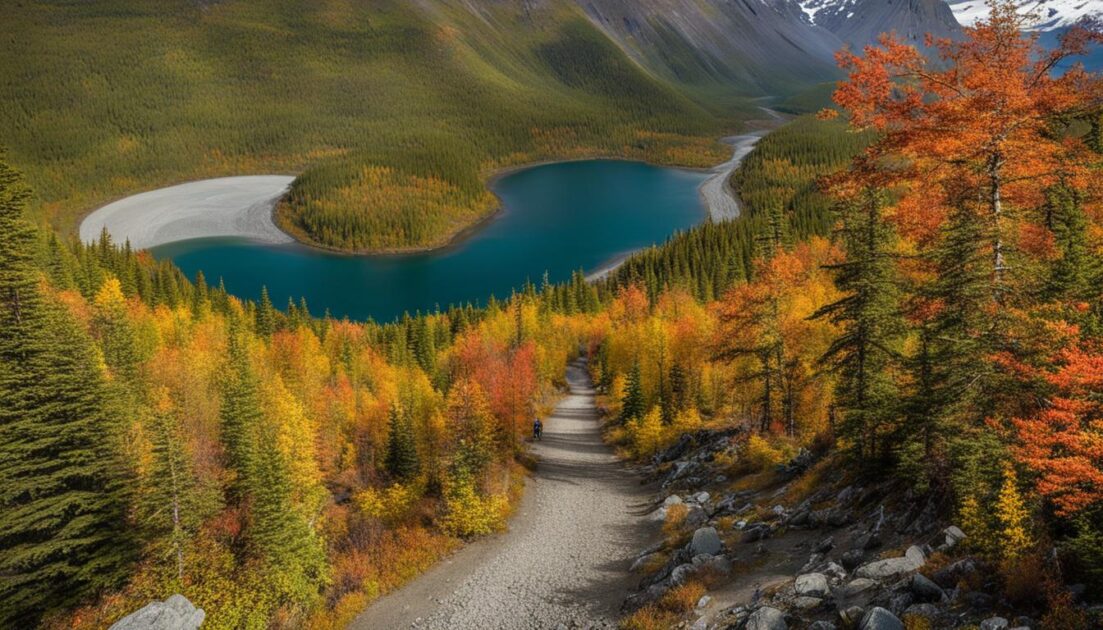Are you ready to embark on an unforgettable hiking adventure in Wrangell, Alaska? Look no further! Wrangell-St. Elias National Park and Preserve offers a plethora of scenic trails that cater to hikers of all levels. Whether you’re an experienced backpacker or a beginner seeking a leisurely walk, Wrangell has something to offer for everyone. From the park’s historical significance to its geological wonders, this outdoor playground is a must-visit destination for nature enthusiasts.
Key Takeaways:
- Explore the diverse hiking trails in Wrangell, Alaska, suitable for all skill levels.
- Discover the historical significance of Wrangell’s hiking trails and immerse yourself in the region’s rich cultural heritage.
- Marvel at the geological wonders that shape the landscape of Wrangell, including towering mountains, glaciers, and unique rock formations.
- Keep an eye out for the abundant wildlife that calls Wrangell home, but remember to observe from a safe distance.
- Plan your hiking trip carefully, considering the seasonal variations and following safety guidelines to ensure a successful and enjoyable adventure.
Easy Hiking Trails in Wrangell
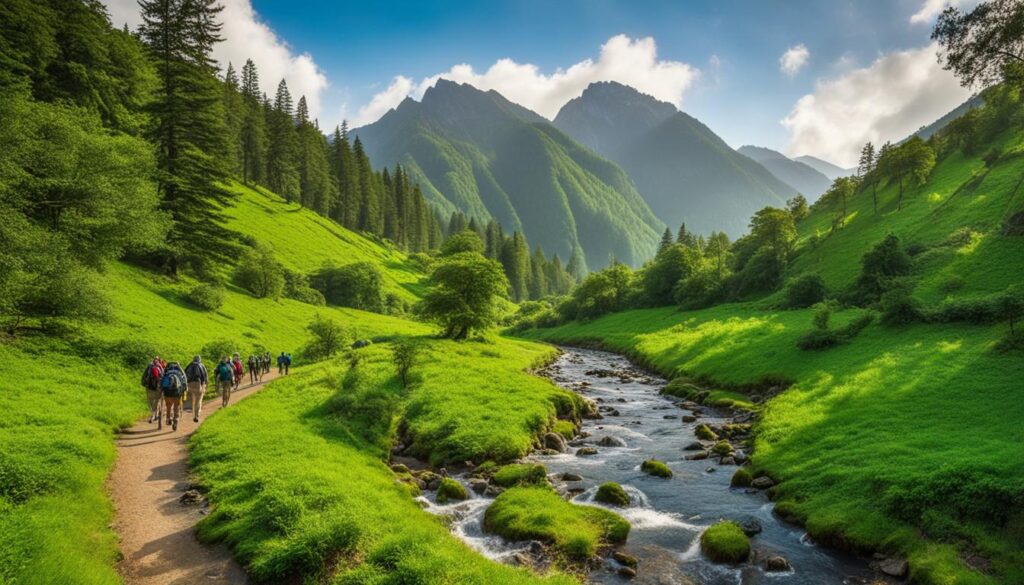
When it comes to easy hiking trails, Wrangell has plenty to offer for beginners and those looking for a leisurely walk. These trails provide an opportunity to enjoy the beauty of nature without the need for advanced hiking skills. Here are some of the best easy hiking trails in Wrangell:
- Nugget Creek Trail: This trail is perfect for a relaxed hike with picturesque views. It leads to a beautiful blue lake and offers stunning scenery along the way.
- Erie Mine Trail: For a glimpse into Wrangell’s mining history, this trail is a must. It follows the Root Glacier and takes you through the historic mining area.
- Copper Center Loop: This scenic loop trail is great for families and offers a chance to explore the area’s diverse wildlife and vegetation.
Before heading out on any of these trails, it’s important to check for trail conditions and weather updates. Also, don’t forget to pack essentials such as water, snacks, sunscreen, and bug spray. These easy hiking trails in Wrangell are the perfect way to enjoy the outdoors and experience the beauty of this Alaskan wilderness.
Trail Difficulty Comparison
| Trail | Difficulty | Distance | Elevation Gain |
|---|---|---|---|
| Nugget Creek Trail | Easy | 3 miles | 400ft |
| Erie Mine Trail | Easy | 2.5 miles | 300ft |
| Copper Center Loop | Easy | 2.8 miles | 150ft |
Hard Hiking Trails in Wrangell
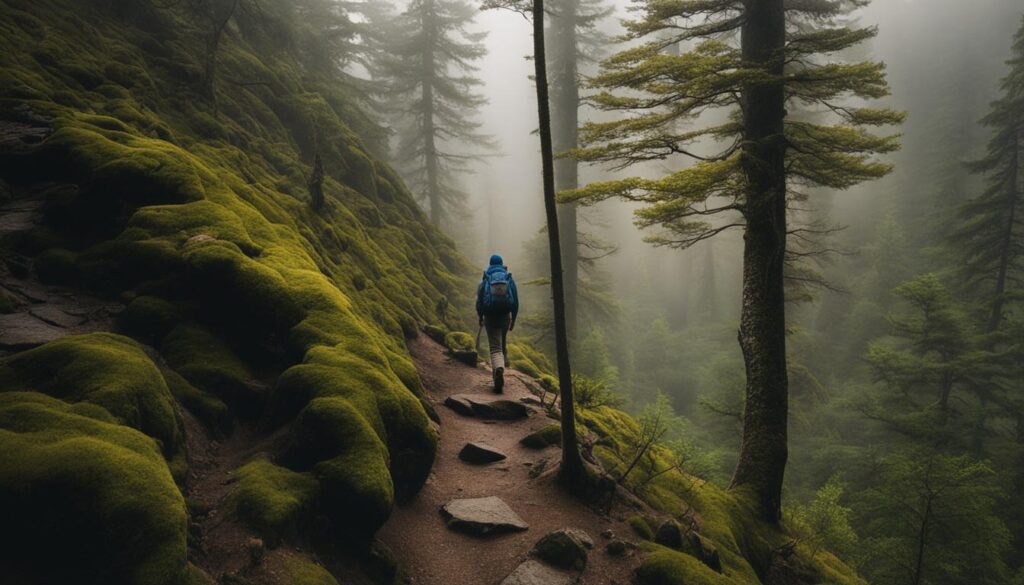
For the more experienced hikers seeking a thrilling adventure, Wrangell offers a range of challenging trails that will push your skills and endurance to the limit. These advanced hikes in Wrangell-St. Elias National Park and Preserve are not for the faint of heart but offer unforgettable experiences for those willing to take on the challenge.
One such trail is the Dixie Pass, known for its off-trail sections and the alpine pass that provides breathtaking views of majestic Mt. Blackburn. This strenuous trek is recommended for experienced hikers who are comfortable with rugged terrain and are equipped with proper navigation tools.
If you’re looking for a more remote and demanding hike, the Goat Trail is the perfect choice. This backcountry route requires expert-level hiking skills and navigation abilities. Along the way, you’ll be rewarded with awe-inspiring vistas of the surrounding mountains, making the effort well worth it.
Table: Comparison of Hard Hiking Trails in Wrangell
| Trail | Difficulty | Highlights |
|---|---|---|
| Dixie Pass | Strenuous | Off-trail sections, alpine pass, views of Mt. Blackburn |
| Goat Trail | Expert-level | Remote backcountry route, stunning mountain vistas |
When embarking on these challenging hikes, it’s essential to come well-prepared. Ensure you have the necessary navigation tools, appropriate gear for the rugged terrain, and ample supplies of food and water. Additionally, familiarize yourself with the trail conditions and weather forecasts, as conditions can change quickly in the backcountry.
Remember, safety is paramount when tackling these difficult treks. Let someone know your hiking plans and expected return time, and never underestimate the challenges that lie ahead. With proper preparation and a sense of adventure, these hard hiking trails in Wrangell will reward you with incredible experiences and unforgettable memories.
Area Hiking in Summer vs Winter
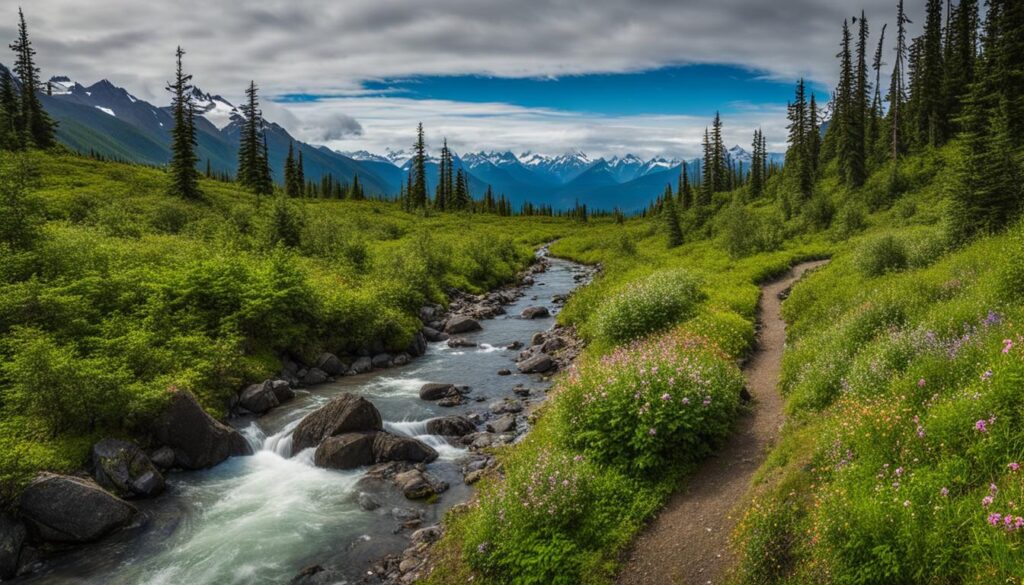
When it comes to hiking in Wrangell, the experience can vary greatly depending on the season. The park offers year-round hiking opportunities, each with its own unique charm. In the summer, hikers can enjoy longer daylight hours and milder temperatures, making it an ideal time for longer hikes and backcountry exploration. The lush greenery and blooming wildflowers create a picturesque backdrop for your adventure. However, be prepared for potential rain showers and pesky bugs that come with the warmer weather.
In contrast, the winter season transforms Wrangell into a winter wonderland. The landscape is blanketed in snow, creating a serene and magical atmosphere. Winter hiking offers a unique opportunity to explore the park’s trails on snowshoes or cross-country skis. The quiet solitude and striking views of snow-capped peaks are truly breathtaking. However, winter hiking requires additional preparation and gear, including proper winter clothing, traction devices for icy trails, and knowledge of winter backcountry travel. Always check trail conditions and be aware of potential hazards, such as avalanche danger.
| Summer Hiking | Winter Hiking |
|---|---|
| Longer daylight hours | Magical winter scenery |
| Milder temperatures | Serene and quiet trails |
| Lush greenery and flowers | Views of snow-capped peaks |
| Potential rain showers | Additional gear required |
| Bugs and insects | Icy trails and avalanche danger |
Whether you prefer the vibrant colors of summer or the tranquil beauty of winter, Wrangell offers incredible hiking opportunities year-round. Each season brings its own set of challenges and rewards, allowing hikers to experience the park’s ever-changing landscape. Whichever time of year you choose to explore Wrangell’s trails, be sure to check the seasonal trail conditions and plan accordingly. With proper preparation and a sense of adventure, you can embark on a memorable hiking journey in Wrangell.
Historical Significance of Wrangell Hiking Trails

Exploring the hiking trails in Wrangell-St. Elias National Park and Preserve offers more than just breathtaking views and outdoor adventures. These trails also provide a unique opportunity to delve into the historical significance and cultural heritage of the area. As I hike through the picturesque landscapes, I am constantly reminded of the rich history that has shaped this region.
One of the most notable aspects of Wrangell’s hiking trails is the presence of historic landmarks. For example, the Erie Mine Trail takes me on a journey through an old mining area, where I can imagine the hustle and bustle of miners chasing their dreams. Walking through this trail, I gain a deeper appreciation for the challenges they faced and the role mining played in shaping the local economy.
Another trail that highlights the historical significance of Wrangell is the Kennecott Glacier route. Here, I have the opportunity to explore the ghost town of Kennecott, once a thriving mining community. The weathered buildings and remnants of the past transport me back in time, offering a glimpse into the lives of the people who once called this place home.
“Walking through these historic hiking trails in Wrangell is like stepping back in time, allowing me to connect with the past and appreciate the efforts and stories of those who came before.”
These hiking trails not only provide a physical challenge and a chance to connect with nature but also serve as a reminder of the cultural heritage and historical significance of Wrangell-St. Elias National Park and Preserve. As I continue my exploration of these trails, I can’t help but feel a sense of gratitude for the opportunity to be a part of this living history.
Geological Wonders in Wrangell Hiking Trails
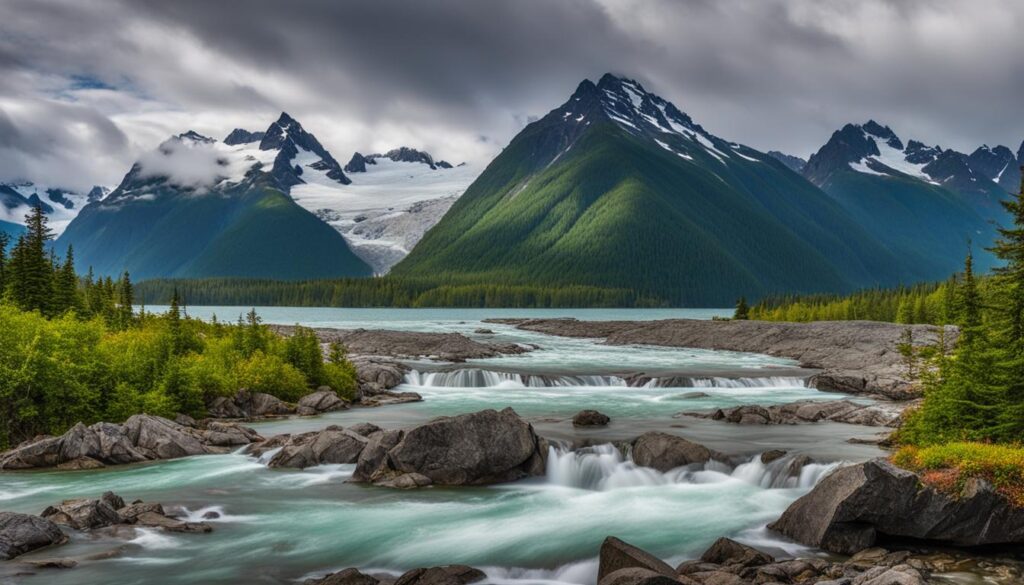
The hiking trails in Wrangell offer a captivating journey through some of nature’s most remarkable geological wonders. As you explore the trails, you’ll encounter unique rock formations, glacial landscapes, and geological points of interest that showcase the park’s awe-inspiring geology.
The Wrangell-St. Elias National Park and Preserve is home to majestic glaciers, including the Russell Glacier and Root Glacier. These massive ice formations provide a glimpse into the powerful forces that have shaped the landscape over thousands of years. Marvel at the breathtaking blue hues of the glaciers and witness the constant movement and transformation of the ice.
Along the hiking trails, you’ll also come across fascinating rock formations that have been sculpted by the forces of nature. From towering cliffs to intricate patterns etched into the rocks, these formations tell a story of the park’s geological history. Take your time to appreciate the intricate details and colors of the rocks, knowing that they have been formed over millions of years.
“The geological wonders found in Wrangell are truly a sight to behold. The combination of glaciers, rock formations, and other unique features make this park a paradise for geology enthusiasts.”
Immersing yourself in the geological wonders of Wrangell is an unforgettable experience. It’s a chance to witness the remarkable forces of nature that have shaped this remote and pristine wilderness. Whether you’re intrigued by glacial landscapes or fascinated by the intricate details of rock formations, Wrangell’s hiking trails offer a front-row seat to some of the Earth’s most breathtaking geological wonders.
| Geological Wonder | Description |
|---|---|
| Russell Glacier | A massive glacier that showcases the power of ice in shaping the landscape. |
| Root Glacier | An opportunity to walk on a glacier and witness its ever-changing beauty. |
| Towering Cliffs | Rock formations that rise high above the surrounding landscape, displaying the incredible forces that have shaped them. |
| Intricate Patterns | Delicate and detailed patterns etched into the rocks, a testament to the intricate processes of geological formation. |
Wrangell-St. Elias Geology: A Fascinating Journey Through Time
The geology of Wrangell-St. Elias National Park and Preserve is a fascinating journey through millions of years of Earth’s history. The park’s diverse landscapes and geological wonders provide a unique opportunity to study and appreciate the Earth’s dynamic processes.
From the sculpted features of glaciers to the intricate patterns in rocks, Wrangell’s geology offers a window into the past. The continuous movement of ice has shaped the valleys and carved out breathtaking fjords. These glacial formations are evidence of the powerful forces that have shaped the landscape over time.
The park is also known for its volcanic activity, with remnants of ancient volcanoes scattered throughout the area. The Wrangell Volcanic Field is one of the most active volcanic regions in North America, featuring volcanic cones, lava flows, and ash deposits. Exploring these volcanic features allows for a deeper understanding of the Earth’s processes and the ongoing forces that shape our planet.
“The geological wonders of Wrangell-St. Elias National Park and Preserve are a testament to the Earth’s incredible power and beauty. It’s a humbling experience to witness the forces that have shaped this magnificent landscape.”
Whether you’re a geology enthusiast or simply appreciate the beauty of the Earth’s natural wonders, Wrangell’s hiking trails offer a remarkable opportunity to explore and learn about the geology of this extraordinary region.
Area Wildlife in Wrangell Hiking Trails
One of the most fascinating aspects of hiking in Wrangell is the opportunity to encounter its diverse wildlife. Wrangell-St. Elias National Park and Preserve is home to a rich fauna, making it a haven for nature lovers and wildlife enthusiasts. The park’s expansive wilderness provides a habitat for a wide variety of animals, from large mammals to avian species.
When exploring the hiking trails in Wrangell, keep your eyes peeled for iconic species such as moose and bears. These majestic creatures can often be spotted grazing or foraging in their natural habitat. Birdwatching enthusiasts will also be delighted by the presence of numerous avian species, including eagles and a variety of songbirds.
It’s important to remember that encounters with wildlife should be done respectfully and safely. Keep a safe distance from the animals and never approach or feed them. Always carry bear deterrents such as bear spray and be aware of the proper protocols for encountering wildlife. Binoculars and a camera are essential gear to capture the beauty of the animals you may encounter along the trails.
“Witnessing the wildlife in Wrangell is a truly awe-inspiring experience. The sight of a moose gazing back at you or a majestic bear roaming the meadows is something I’ll never forget.” – Hiker in Wrangell
| Animal | Commonly Spotted in Wrangell |
|---|---|
| Moose | These gentle giants are often seen grazing near lakes and rivers. |
| Bears | Both black bears and brown bears can be spotted in Wrangell, particularly in meadows and forested areas. |
| Eagles | The park is home to various species of eagles, and their soaring flights can be observed throughout the area. |
| Songbirds | Wrangell’s forests are filled with the melodious tunes of various songbird species, creating a harmonious atmosphere during hikes. |
Exploring Wrangell’s hiking trails provides a unique opportunity to connect with nature and observe the wildlife that calls this stunning landscape home. Keep in mind the importance of respecting the animals’ space and enjoying their presence from a safe distance. With a little patience and a keen eye, you’re sure to have unforgettable wildlife encounters during your adventures in Wrangell.
Scenic Viewpoints in Wrangell Hiking Trails
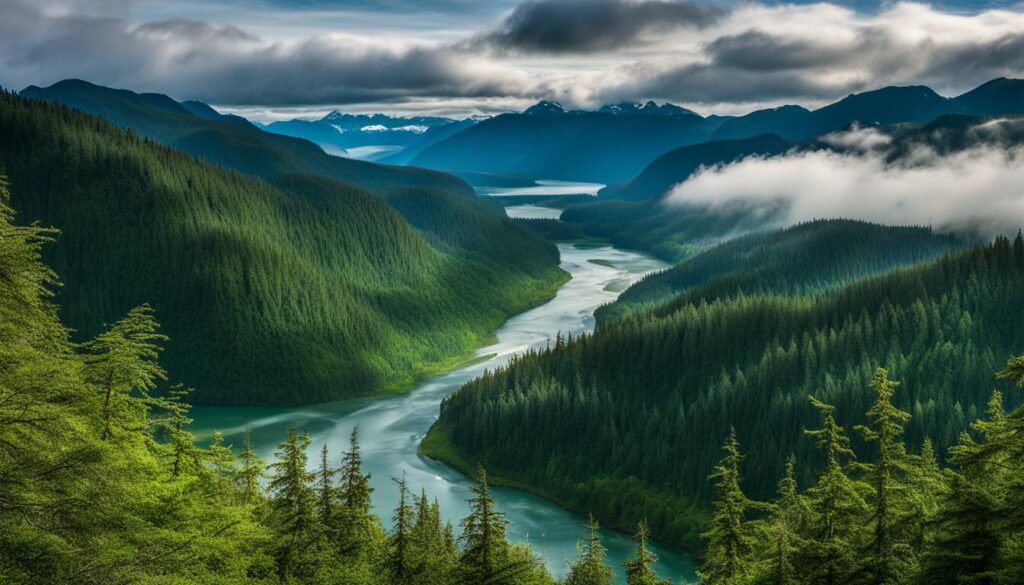
Exploring the hiking trails in Wrangell offers a feast for the eyes, with numerous scenic viewpoints that showcase the breathtaking beauty of the surrounding landscapes. From panoramic vistas to picture-perfect photo spots, these observation points in Wrangell-St. Elias National Park and Preserve will leave you in awe.
Table: Top Scenic Viewpoints in Wrangell
| Name | Location | Highlights |
|---|---|---|
| Dixie Pass | Near McCarthy | Stunning views of Mt. Blackburn and alpine landscape |
| Skolai Pass | Upper Chitina River | Sweeping views of rugged terrain and glaciated peaks |
| Chitistone Pass | Chitistone River Valley | Breathtaking vistas of jagged mountains and expansive valleys |
These scenic viewpoints provide the perfect backdrop for capturing memorable photos and immersing yourself in the grandeur of Wrangell’s wilderness. Whether you’re gazing at the towering peaks, marveling at the vast glaciers, or admiring the untouched valleys, these observation points will leave a lasting impression.
“The beauty of the Wrangell-St. Elias National Park and Preserve is truly awe-inspiring. Standing at these scenic viewpoints, you’ll be reminded of the incredible power of nature and the importance of preserving these landscapes for future generations to enjoy.” – Hiker Joe
As you hike through Wrangell, be sure to take the time to appreciate the panoramic views and breathtaking vistas that these scenic viewpoints offer. Each one provides a unique perspective of the park’s natural wonders and serves as a reminder of the incredible forces that have shaped this rugged wilderness.
Trip Planning for Wrangell Hiking
Planning a hiking trip in Wrangell-St. Elias National Park and Preserve requires careful preparation to ensure a safe and enjoyable experience. Here are some essential tips for trip planning:
1. Research the Trails
Start by researching the hiking trails in Wrangell to find the ones that suit your skill level and interests. Consider the distance, elevation gain, and difficulty of each trail. Look for trail descriptions and reviews from other hikers to get a better idea of what to expect.
2. Obtain Permits
If you plan to do any backcountry camping during your hike, you will need to obtain permits. Check the park’s website or contact the ranger station for information on obtaining permits and any specific regulations or restrictions.
3. Pack Essential Gear
Make sure to pack essential gear for your hiking trip. This includes proper footwear, clothing layers for changing weather conditions, navigation tools like a map and compass, and a first aid kit. Carry enough food and water for the duration of your hike, and don’t forget to bring bear deterrents if you’ll be hiking in bear country.
4. Familiarize Yourself with Trail Maps
Before heading out on the trail, familiarize yourself with trail maps. Study the route, look for points of interest, and make note of any potential hazards or challenging sections. Having a good understanding of the trail before you start hiking will help you navigate with confidence.
5. Share Your Itinerary
Always let someone know your hiking itinerary, including the trail you’ll be on and your expected return time. This way, if something goes wrong or you encounter any difficulties, someone will know where to look for you.
| Essential Gear | Additional Tips |
|---|---|
|
|
By following these trip planning tips, you’ll be well-prepared for your hiking adventure in Wrangell. Remember to always prioritize safety, respect the natural environment, and enjoy the stunning beauty of Wrangell-St. Elias National Park and Preserve.
Conclusion
As I wrap up my exploration of Wrangell’s hiking trails, I can’t help but be amazed by the incredible experiences this national park has to offer. From easy trails perfect for beginners to challenging treks that test your skills, Wrangell truly caters to all types of hikers.
Not only does Wrangell-St. Elias National Park and Preserve showcase its historical significance and geological wonders, but it also provides opportunities to witness wildlife in their natural habitat and enjoy breathtaking scenic viewpoints. The park’s diversity is truly remarkable.
Before embarking on your hiking adventure in Wrangell, make sure to plan your trip carefully and follow safety guidelines. Familiarize yourself with the trail conditions, obtain any necessary permits, and pack the essential gear. Remember to practice Leave No Trace principles and respect the natural environment.
So, whether you’re an experienced hiker eager for a new challenge or a beginner looking to connect with nature, Wrangell awaits you with open arms. Get ready to create unforgettable memories as you explore the stunning beauty of Wrangell hiking trails.
FAQ
Are there easy hiking trails in Wrangell?
Yes, Wrangell offers several easy hiking trails that are suitable for beginners or those looking for a leisurely walk.
What are some popular easy hiking trail options in Wrangell?
Some popular easy hiking trail options in Wrangell include the Nugget Creek Trail, which leads to a blue lake with beautiful views, and the Erie Mine Trail, which follows the Root Glacier and explores a historic mining area.
Are there challenging hiking trails in Wrangell?
Yes, Wrangell offers challenging hiking trails for more experienced hikers who are looking for a test of their skills and endurance.
What are some examples of challenging hiking trails in Wrangell?
Examples of challenging hiking trails in Wrangell include the Dixie Pass trail, which has off-trail sections and an alpine pass with stunning views of Mt. Blackburn, and the Goat Trail, a remote backcountry route that requires navigation skills and offers breathtaking views of the surrounding mountains.
Can you hike in Wrangell year-round?
Yes, Wrangell offers hiking opportunities year-round, but the experience can vary depending on the season.
What are the differences between hiking in Wrangell in the summer and winter?
In the summer, hikers can enjoy longer daylight hours and milder temperatures, making it an ideal time for longer hikes and backcountry exploration. In the winter, the landscape transforms into a winter wonderland, offering opportunities for snowshoeing and cross-country skiing.
Do the hiking trails in Wrangell have historical significance?
Yes, many of the hiking trails in Wrangell have historical significance and offer insights into the region’s rich cultural heritage.
What are some examples of hiking trails with historical significance in Wrangell?
Examples of hiking trails with historical significance in Wrangell include the Erie Mine Trail, which takes hikers through an old mining area, and the Kennecott Glacier, which allows exploration of the ghost town of Kennecott, once a thriving mining community.
Are there any geological wonders along the Wrangell hiking trails?
Yes, Wrangell offers a variety of geological wonders, from towering mountains and glaciers to unique rock formations.
What are some examples of geological wonders along the Wrangell hiking trails?
Examples of geological wonders along the Wrangell hiking trails include the Russell Glacier and Root Glacier, which provide up-close views of impressive ice formations, and various rock formations that showcase the area’s geologic history.
Can you spot wildlife on the Wrangell hiking trails?
Yes, Wrangell is home to a wide variety of wildlife, and hiking trails offer opportunities to observe these animals in their natural habitat.
What wildlife can be seen on the Wrangell hiking trails?
Wildlife that can be seen on the Wrangell hiking trails includes moose, bears, eagles, and a variety of songbirds.
Are there scenic viewpoints along the Wrangell hiking trails?
Yes, Wrangell’s hiking trails offer breathtaking panoramic views and scenic viewpoints that will leave hikers in awe.
What are some examples of scenic viewpoints along the Wrangell hiking trails?
Examples of scenic viewpoints along the Wrangell hiking trails include the top of Dixie Pass, which offers stunning views of Mt. Blackburn and the alpine landscape, and the Skolai Pass and Chitistone Pass routes, which provide sweeping views of the rugged terrain and glaciated peaks.
What should I consider when planning a hiking trip in Wrangell?
When planning a hiking trip in Wrangell, it’s important to research the trails, select ones that suit your skill level and interests, obtain any necessary permits for backcountry camping, familiarize yourself with park regulations, pack essential gear, carry trail maps, be aware of potential hazards, and let someone know your itinerary before heading out.

